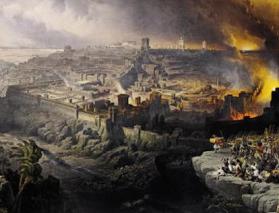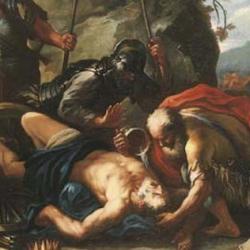The final section of 1 Chronicles is neatly framed by speeches by David. Chapter 22 contains David’s speech of encouragement to Solomon, concluded by a brief exhortation to “all the leaders” (22:17–19). Chapters 28–29 record several public speeches, marked by “David said” and interspersed with descriptions of temple furnishings:
1. Speech #1: David addresses officials, princes, commanders, overseers, 28:1–10
2. David gives to Solomon the tabnit/pattern for the temple and its furnishings, 28:11–19
3. Speech #2: David exhorts Solomon to be strong and courageous, 28:20–21
4. Speech #3: David details his contributions and calls for contributions, 29:1–5
5. Contributions of rulers, princes, commanders, overseers, 29:6–9
6. Speech #4: David blesses Yahweh, 29:10–19
7. Speech #5: David calls on assembly to bless Yahweh, 29:20
How fitting that the last recorded words of David are, “Now bless Yahweh your God” (29:20).
Between these two speeches are several chapters concerned with David’s organization of the personnel of the temple. In these chapters, the physical temple fades from view. David mentions the gold he has gathered in his initial speech (22:14); gold is not mentioned at all in chapters 23–27, but is a major concern of David’s final speech (28:14–18; 29:2–5, 7). The same pattern is evident with bronze (22:14, 16; 29:2) and silver (22:16; 28:14–17; 29:2–5, 7). The verb “build” appears 8x in chapter 22 (vv. 2, 6, 7, 8, 10, 11, 19), never in chapters 23–27, and another 7x in chapters 28-29 (28:2 [2x], 3, 6, 10; 29:16, 19). David’s speeches are concerned with the temple; David’s actions between the speeches are entirely concerned with people.
David’s organization of personnel is structured is recorded quasi-chiastically:
A. Levites, 23:1–32
B. Priests, 24:1–31
C. Musicians, 25:1–31
B’. Gatekeepers, 26:1–32
A’. Laity, 27:1–34
It’s a chiastic shape, but is perhaps better described as an architectural structure. The outer edges of the text list those who function in the outer parts of the temple – Levites who assist with sacrifices in the court but never enter the house, and lay Israelites who also enter only the court. Priests work in the house itself, and gatekeepers, of course, guard entrances and exits. If you were to enter the temple precincts, you’d first pass through the court with its Levites and lay worshipers, then past the gatekeepers, and then into the temple proper, where the startled priests would wonder how the hell you got past the gatekeepers.
At the center of the literary structure is a list of Levitical musicians. Music is the center of the text, as music became the center of Israel’s worship. If we stick with the architectural pattern, music is set in the inner sanctuary, at the ark. It is a literary portrait of the fact that Israel continued to carry on the worship of the Davidic tabernacle—song offered at the ark—even after the temple was finished. It seems a literary-structural rendition of Psalm 22:3: “You are holy, O You who are enthroned upon the praises of Israel.”
This music-centered segment forms a neat enclosure for the opening chapters of 1 Chronicles, the genealogies that are also organized chiastically, also with music in the middle.











